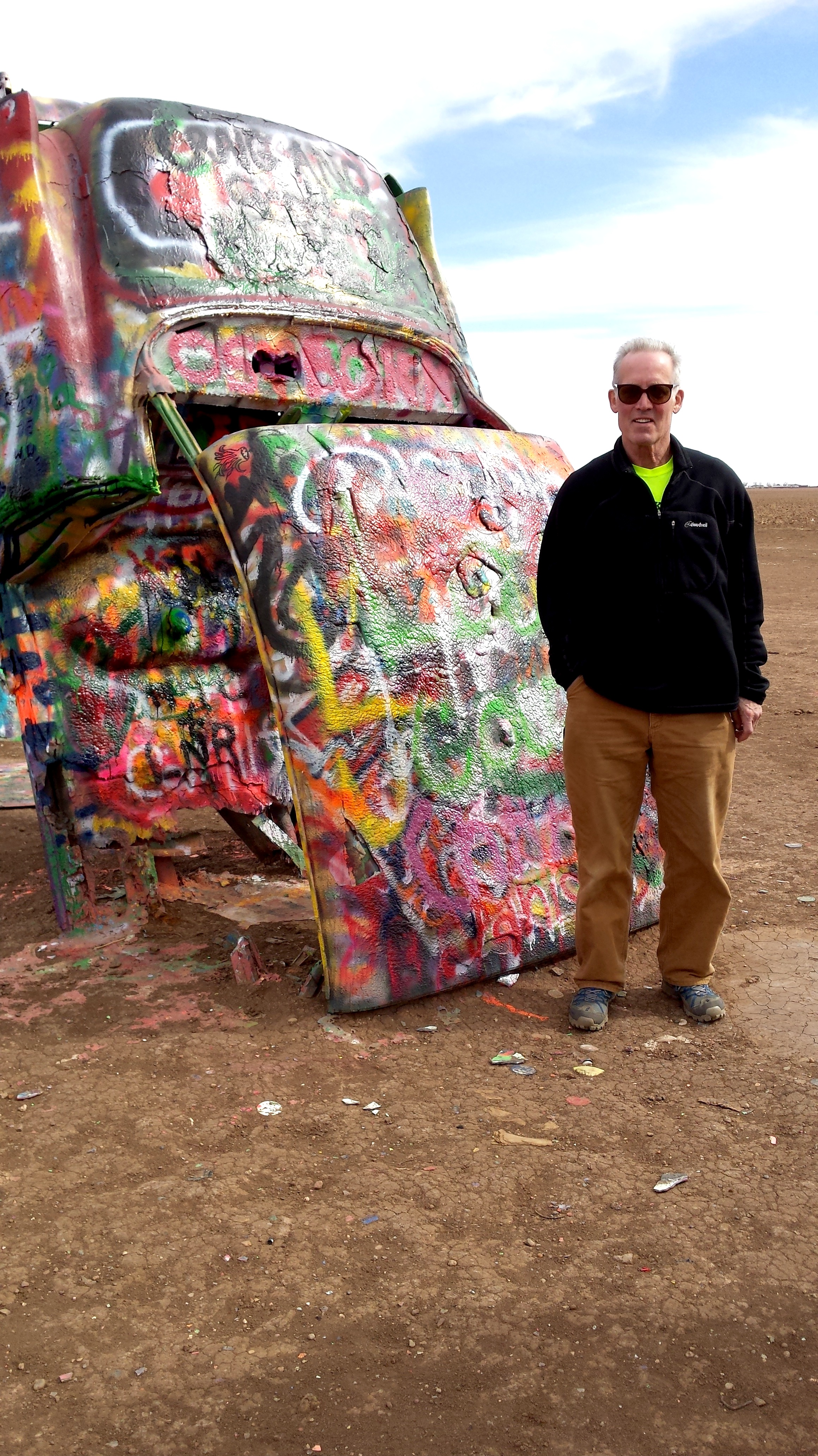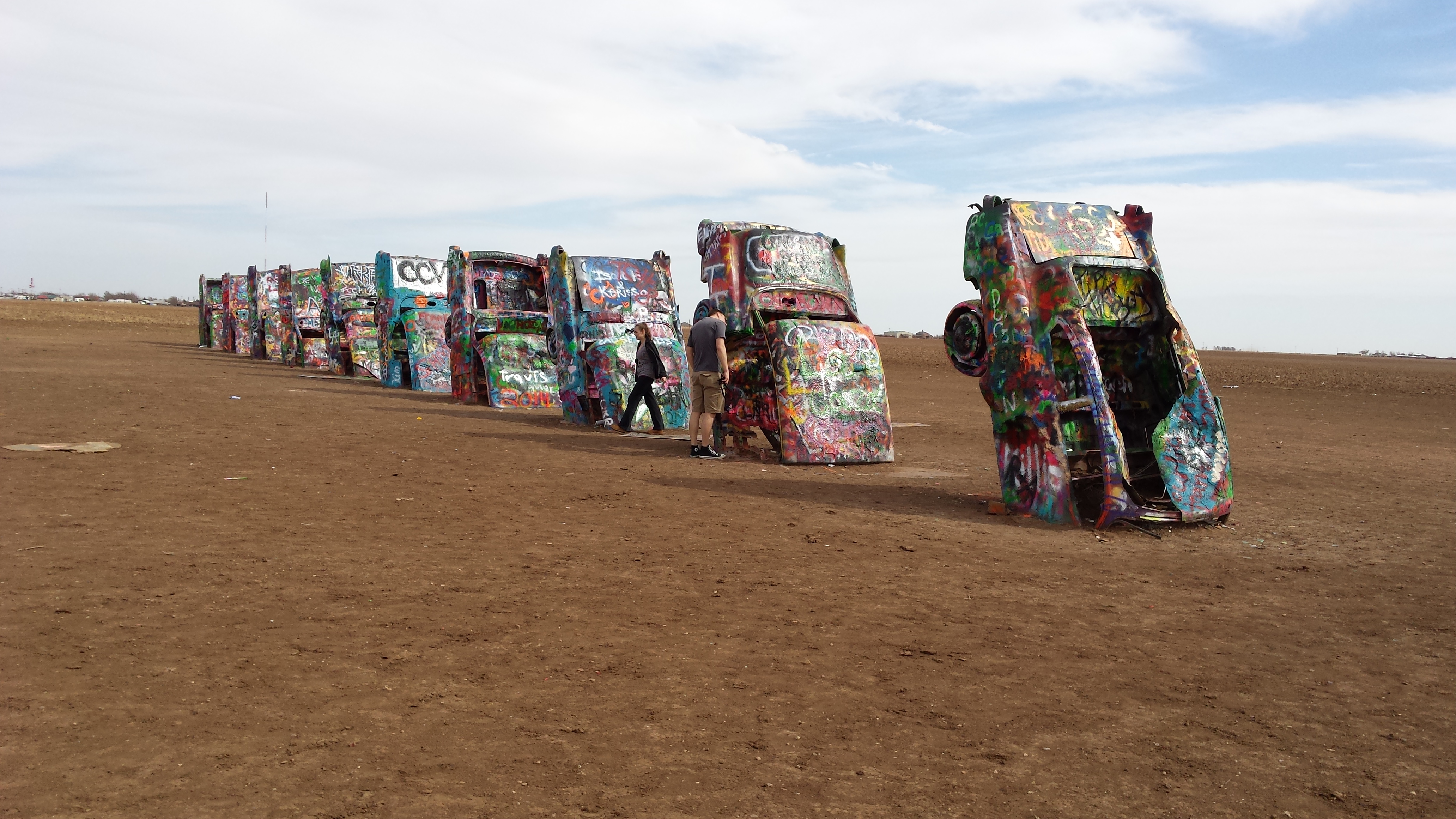Cadillac Ranch
“We have to go to Amarillo,” I told Harry.
“Why Amarillo?” he asked.
“Cadillac Ranch, of course.”
I’m not sure what my fascination has been with Cadillac Ranch, but since I first heard of the art installation years ago, I’ve been longing to see it in person. It’s not about the Bruce Springsteen song from 1980, and it’s not that I’m in love with Cadillacs. I had a Cimarron once, Cadillac’s experiment with a compact car. The Cimarron was built heavy for safety, but its four-cylinder engine didn’t have enough spunk to accelerate from the on-ramp onto an expressway, and forget about going up steep hills. One day while I was stopped at a yield sign to wait for an oncoming car, a woman rear-ended me and the Cimarron was totaled. After a bit of whiplash, I took the settlement money and bought a Honda.
No, Cadillac Ranch isn’t about Cadillacs. The sculpture, if we can call it that, is in a cow pasture set back from Interstate 40 outside Amarillo. The property is in the trust of the late Stanley Marsh, a patron of Texas arts. To get there I typed “Cadillac Ranch” into my phone, and Gertrude led us to the site. When I saw the Cadillacs lined up on the horizon, I couldn’t get out of the Bug fast enough.
The 1974 artwork is the brainchild of a group of artist-hippies from San Francisco who called themselves Ant Farm. Their idea was to construct an artistic composition that paid homage to environmentalism—art with free admission. Twelve rusting Cadillacs dating from a 1949 Club Sedan to a 1963 Sedan de Ville are buried nose first in a straight line, tailfins high. A backhoe hoisted the autos by their axles and eased them into holes eight feet deep. Then a mixer truck poured in concrete to set the vehicles at a uniform angle identical to that of the Great Pyramid of Giza—51.84 degrees.
What was it about the Great Pyramid that piqued the interest of Ant Farm? It could have been the antiquity of the 2560 BC king’s tomb or the two and a half million limestone blocks that comprise it, each weighing over two tons moved and mysteriously carved without the use of pulleys, wheels or iron tools. Or maybe the artists were fascinated with the concentrated energies focused in the main chamber that are most potent when the earth aligns with solar, lunar and stellar bodies. Supposedly one experiences spiritual awakening and enlightenment when exposed to these energies. Researchers have found that foods placed in similar pyramids don’t spoil, razor blades sharpen, plants germinate, and wounds heal quickly.
Nothing mystical happened to me at Cadillac Ranch—at least, not that I noticed. What I did notice, though, was a sense of pure joy. The property is fenced off, but the gate is unlocked and visitors are invited to enter. Most of the people parading out to the pasture carried spray paint cans. The cars are alive with bright graffiti colors, and the air is perfumed with aerosol paint. One young woman in cutoff shorts sprayed gleefully while we were there, and a middle-aged man walked among the Cadillac coffins with a huge smile on his face.
What? We’re allowed to participate in art, even deface it? What fun!
The cars have been painted to commemorate events—flat black to mark the passing of an Ant Farm member, white for filming a commercial, pink for the birthday of artist Marsh’s wife, rainbow colors for the 2012 Gay Pride Day. But the day we were there, they were splattered with day-glo poetry, abstract designs, and tributes to lovers and alma maters.
Perhaps what pulled me to Cadillac Ranch was nostalgia for the days when cars had big engines with lots of horsepower, gasoline was cheap, and my family drove into the mountains on Sundays just for enjoyment—albeit in our Chevy. Maybe I wanted to embrace again the American Dream we all once hoped for—a life where anything is possible. Those hopes seem to be buried in a rusting Cadillac graveyard where the young are invited to vent their frustrations with spray paint. Poignancy at its best.
As Harry and I walked back to our high-tech Bug that runs on diesel fuel, I couldn’t help but look back at the Cadillacs, one behind the other as if marching back through time. I wanted to linger, to think about both the cars and the ranks of people who kept coming and coming to see the installation. There was something—not quite like the Great Pyramid of Giza—but something mystical nonetheless.